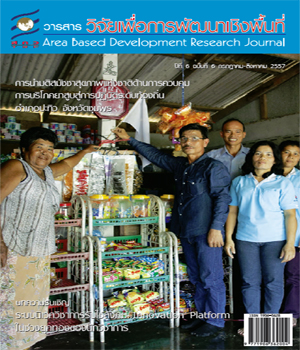รูปแบบวรรณกรรมและศิลปะ ที่สามารถเสริมสร้างความมั่นคงด้านจิตใจ เพื่อให้เยาวชนตระหนักคุณค่าในตนเอง : กรณีศึกษา ชุมชนวังทอง
Main Article Content
Abstract
งานวิจัยนี้เป็นการวิจัยเชิงคุณภาพ (Qualitative Research)ที่ใช้รูปแบบการวิจัยเชิงปฏิบัติการแบบมีส่วนร่วม (Participatory Action Research: PAR) เพื่อศึกษาสถานการณ์ปัญหาเด็กและเยาวชนในชุมชนวังทอง อำเภอเมือง จังหวัดอุบลราชธานี และศึกษารูปแบบการใช้วรรณกรรมและศิลปะที่สามารถเสริมสร้างความมั่นคงด้านจิตใจให้เยาวชนตระหนักคุณค่าในตนเอง กลุ่มเป้าหมายคือเยาวชนในเขตชุมชนวังทอง ตำบลในเมือง อำเภอเมือง จังหวัดอุบลราชธานี ได้แก่ เด็กที่มีอายุระหว่าง 0-6 ปี 6-12 และวัยรุ่นที่มีอายุ13-16 ปี เครื่องมือวิจัยประกอบด้วย การสังเกตพฤติกรรม การสัมภาษณ์เยาวชน และแบบวัดความภาคภูมิใจในตนเองที่พัฒนาจากแนวคิดของโรเจอร์ รูบิน และคูเปอร์สมิธ การใช้สื่อวรรณกรรมเยาวชนประเภทนิทาน หนังสือภาพ และเรื่องเล่าจากชุมชนและ กิจกรรมค่ายวรรณกรรมและศิลปะ วิเคราะห์ สังเคราะห์ข้อมูลด้วยการวิเคราะห์เนื้อหา (content analysis) และวิเคราะห์ส่วนประกอบ (componential analysis)ผลการศึกษาที่สำคัญพบว่า เยาวชนมีพื้นฐานที่หลากหลายทางเศรษฐกิจสังคมและบุคลิกภาพ ส่วนน้อยที่มีความรู้สึกว่าเป็นกลุ่มคนขาดโอกาสในการศึกษาในระบบ บ้างต้องการให้เพื่อนในชุมชนเห็นความสำคัญของตนมากขึ้น และบางคนขาดความมั่นใจในการทำกิจกรรมกลุ่ม กิจกรรมค่ายที่จัดสองครั้งประกอบด้วยการอ่านและเล่านิทาน การทำหนังสือภาพ การแสดงละคร การทำหุ่นละคร และการทำสมุดทำมือ พบว่า ลักษณะกิจกรรมที่สามารถเสริมสร้างความมั่นคงด้านจิตใจและตระหนักในคุณค่าตนเอง ได้แก่ 1)วรรณกรรมที่มีแนวคิดหลักเกี่ยวกับการยอมรับความแตกต่างในสังคม แนวคิดเรื่องการปรับตัวเข้ากับเพื่อน และแนวคิดเรื่องการให้อภัย 2) ศิลปะการแสดงละคร 3) การวาดรูปประกอบเรื่อง และ 4) การทำสมุดทำมือ และ 5) กิจกรรมผสมผสาน ซึ่งทุกกิจกรรมทำให้เด็กและเยาวชนมีพื้นที่ของตนเอง กล้าแสดงออก สร้างความตระหนักรู้ในตนและความสามารถของตน รู้จักปรับปรุงพฤติกรรมและสามารถเพิ่มระดับการควบคุมอารมณ์โกรธตนเอง เด็กและเยาวชนสะท้อนว่าตนเองมีความรู้สึกภาคภูมิใจในผลงานศิลปะของตนเอง มีความสุขที่ได้ทำกิจกรรมและได้รับการยอมรับจากเพื่อนนอกกลุ่มมากขึ้น ผลของกิจกรรมได้ก่อให้เกิดการตื่นตัวในการพัฒนาด้านเยาวชน เกิดการยอมรับทางสังคมภายในระหว่างกลุ่มมากขึ้นเพราะกิจกรรมทำให้ผู้ปกครองมีจิตอาสาช่วยเหลือกัน ตระหนักในความสำคัญของการป้องกันความเสี่ยงเยาวชนหลงผิด และมีการขยายพื้นที่ให้เยาวชนได้เข้ามาใช้ทรัพยากรพื้นที่ของชุมชนในการเรียนอ่านเขียนและวรรณกรรมเยาวชน
The Forms and Characteristics of Children’s Literature and Art That Can Strengthen Youth’s Self-Esteem
The research aimed at finding the forms and characteristics of literature and art that helped build and establish self-esteem in young people. The target participants were youth, 0-6, 6-12 and 13-16 years of age, in Wangthong community in Muang District, Ubon Ratchathani province. In studying the youth’s background and problems, the researcher observed behaviors, interview with youth and other related members in the community, and a self-esteem questionnaire, an inventory developed from Roger Rubin and Coopersmith’s self-esteem measuring tools. The results showed a wide range of youth’s socioeconomic backgrounds: a few felt marginalized in the formal education system, some wanted to gain recognition from their peers. Based on the survey of youth background, the researcher used literary books including children’s tales, story picture books and oral history of the community and brought to the target youth via literary and art camps. Then, two camps were held to inculcate literacy and art appreciation among the target youth group. The camp activities included storytelling, picture book group reading, chikdren’s theatre, making puppets, and do-it-yourself journal binding. The activities yielded results on five characteristics or forms of literature and art that help the youth develop their self-esteem: 1) children’s story in the format of picture book that had themes of tolerance and differences in social backgrounds, self adaptation into social group, and forgiveness; 2) Children’s theatre; 3) illustrating story book ; 4) journal book binding; and 5) combined art and literary activity. All of the activities essentially provided youth with performing space, enforcing selfconfidence, building self-awareness and self-competency, learning to adjust behaviors when interacting with peers, and increasing self-control in anger management. The participants reflected that they were proud of their artistic crafts and happy to be involved in the activities, and they gained recognition from peers other than their acquainted group. In addition, bring art and literary activities to the community enticed the community as a whole to be more active in youth development, increased level of social acceptance among the adults, and became more alert of youth risks. Finally, the community has opened their minds to let youth share communal center as a resource of literacy and literary learning.
Article Details
Area Based Development Research Journal values copyright protection and licensing to safeguard author rights and facilitate the appropriate dissemination of research. Our policies ensure openness, accessibility, and attribution. Authors retain copyright ownership, and articles are published under a Creative Commons Attribution License (CC BY), allowing sharing, adaptation, and proper attribution. Authors have the freedom to publish under the CC BY license, granting broad reuse and distribution permissions. The journal supports posting articles on third-party repositories, adhering to institutional and funding restrictions. Author guidelines detail copyright and licensing requirements, empowering authors with knowledge about their rights and responsibilities. These policies cultivate an environment of collaboration, openness, and responsible sharing, benefiting authors and the research community while honoring intellectual property rights.


